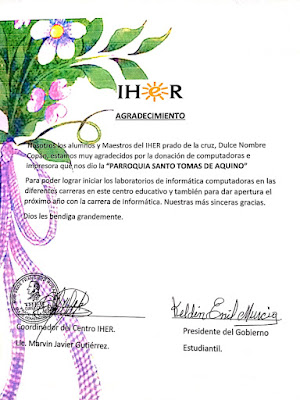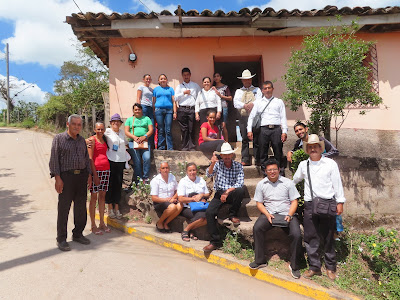 |
| 2023 - election of catechumens |
But our parish is so different.
The parish of Dulce Nombre de María includes about 45 widely scattered places of worship, in five municipalities. Four of these are the municipal seats – Dulce Nombre is the largest of these and has three churches.
Some of the aldeas, villages, are fairly large with more than 1000 people, including El Zapote Santa Rosa, Candelaria Concepción, Plan Grande Concepción. There are a few places that are more like hamlets, caserios, with a few families or even just one extended family.
Religious formation takes place in the cities, villages, and hamlets. Sometimes there is only one catechist. Many of the catechists have limited formal education. This past year there have been several young people who are in formation to be catechists in their communities. In one, more than five are in formation; most of them were confirmed last year.
The bishops’ conference and the diocese are promoting religious formation by levels. This is difficult for us because of the number of catechists we have. We were about to do pilot projects in three places when the pandemic changed our plans.
Most of our formation is preparation for the sacraments.
There are three different formal processes for the sacrament of baptism.
For children under seven, the formation is for parents and godparents: six sessions and a retreat. Each year there are one or two celebrations of baptism of children in most communities.
There is a separate process for children between seven and thirteen. This is almost a year long and begins whenever the catechists on a village are ready to do the catechesis and have enough candidates.
 |
| A baptism in 2016 in Plan Grande |
The third process is for those fourteen and older, the catechumenate.
For a number of reasons, a fair number of young people are not baptized as babies and so there are a good number of children between 7 and 13 baptized in their communities. And there are also young people who wait until they are 14 or older.
There is not a tradition of baptism soon after birth. I have baptized few babies less than a year old. I am not sure if there are cultural reasons or if this is merely a holdover from the time when the parents had to be married in the church and in a base community in order to have their children baptized. (Thanks be to God this ended in our parish in 2013 with the new pastor, Padre German.)
There are usually a good number of children between 7 and 13 who are baptized each year. (There were more in the past when the regulations about married parents were in effect.)
This year we have about 37 catechumens who will, God willing, be baptized at the Easter Village. More than 12 of them are over 18, though the majority are between 14 and 18.
We are probably one of the few parishes in the diocese who have a program for Christian initiation of adults.
Due to the expanse of the parish, we don’t have a centralized catequesis. Most of the formation goes on in the local community, even if there is only one candidate. I have tried to encourage neighboring communities to join together and this has happened in a few places.
The formation normally begins 8 or 9 months before Easter.
We do celebrate the major rites in the main parish church in Dulce Nombre.
We celebrate the rite of acceptance into the catechumenate on the first or second Sunday of Advent.
This past December we celebrated the rite on December 4, since the first Sunday of December we had the visit of the image of Our Lady of Suyapa in our parish. There were 40 candidates.
We use the rites from Mexico, although I have added the signing of the feet from the US Spanish version. I think it is such a significant part of the rite that we have adapted it for our parish. How important it is to see godparents, priests, and even a deacon on their knees, signing the feet of the candidate!
 |
| signing of the hands |
This past Sunday we celebrated the Rite of Election in the church with 36. A few dropped out. One has Sunday morning classes and couldn’t get permission for the rite. Another didn’t get to the church on time – a longer story. The pastor or I will arrange for the rite in their communities.
Since we don't have a book of the elect and because some of the catechumens can't write their names, we give each a card and have someone write their name. They sign or put their thumbprint on the card. In the rite we have them come forward, put the card in a bowl and say their name aloud.
I had enough energy to be able to help arrange the rite at a special Mass at 10 am in the parish. I even preached – very much inspired by the presence of so many catechumens. I reminded them that they were elected (elegidos) – not like the politicians, but “chosen” (elegidos) by the Church, the People of God.
The diocesan radio station, Radio María, broadcasts Masses every Sunday and usually broadcasts a Mass from Dulce Nombre once a month. Yesterday’s Mass and Rite of Election were broadcast. I talked to the staff of the Radio who were unfamiliar with the Rites of the Christian Initiation process.
In Lent, there are a number of rites and activities for the “elect.”
There are three scrutinies which involve prayer and “exorcisms” as well as the handing on (entrega) of the Creed and of the Our Father.
We have designed our formation so that the Creed and the Our Father are handed to the elect during their weekly sessions.
But I was concerned about the scrutinies. It would be a major burden (of time and money) to have them come to one of the Sunday Masses, if they lived far from the Mass sites.
Where there is a Mass nearby or where I could get to a Sunday morning celebration, we would use the scrutinies in the rite.
The pastor usually celebrates Mass in five different sites – Saturday evening in Dolores, Sunday morning in Concepción and in the Saint Anthony Church in Dulce Nombre, Sunday evening in the main church in Dulce Nombre. He also usually has one or two Masses in other places in the afternoon – every other week in San Agustín.
 |
| Scrutiny in San Agustín, 2018 |
I have tried to get to a village with “elect” for the rites on several Sunday mornings. It has been a real blessing, especially when a community has several “elect”.
I spoke with Padre German about this yesterday and gave him the list of communities where there are “elect” as well as the scrutiny rites. He visits communities for Mass every day. His suggestion is that he could preside at the scrutinies at the Mass in the community during the week. For me, that seems great.
My pastoral solution for the other communities was to do a minor re-write of the scrutinies so that they could be celebrated without a priest or deacon in the communities. The scrutinies of the “elect” would take place in a community Celebration of the Word, led by the local Delegate of the Word and Catechist
In the past, the final preparation for the Easter Vigil was a retreat in their communities. But this often meant that there were only one or two in the retreat. This year we will have a retreat for all the “elect” on the Tuesday of Holy Week. This shouldn’t be a major problem since Holy Week (Semana Santa) is a major holiday.
In our parish most local communities pray the Stations of the Cross in the streets of their villages on the Fridays of Lent. In addition, we have a parish wide Stations of the Cross on the Friday before Holy Week, traditionally the feast of Our Mother of Sorrows. We encourage our elect to take part in these as part of their preparation.
The Easter Vigil is quite a celebration here. We begin in a field with the Easter Fire and then go in procession with the Paschal Candle to the Church.
 |
| 2015 |
 |
| 2022 |
Last year we used the auditorium to accommodate all the people who came.
 |
| 2022 |
I’ve sung (or tried) to sing the Exultet, though I may not try this year, due to my health. We also use all the readings and sing all the psalm and canticle response.
Baptism is not a simple pouring of a little bit of water. The elect are baptized in a bath of water!
In many parts of the world, the catechumens are fully initiated in the Church in the Easter Vigil receiving the three sacraments of initiation – Baptism, Eucharist, and Confirmation.
I am not sure why, but in our diocese the catechumens have not been confirmed. I guess the bishops want to confirm them, probably to connect them with the universal church. I can see why those under eighteen might wait until they can be confirmed with other young people of their communities, forming a community in the preparation for confirmation. But those over eighteen? I am trying to get our bishop to permit our pastor to confirm those who are eighteen or older.
With all the readings and baptisms, the Easter Vigil celebration can last from 5 to 6 hours.
We are not very good with the mystagogia – the continuing formation after Easter, trying to incorporate the newly baptized into the community.
This year I’ve asked the catechists to bring all the newly baptized to the Pentecost Vigil, which, for us, is an all-night vigil.
I need to think of other ways to involve the newly baptized in the life of the church, especially those who are adults, eighteen or older.
In the meantime, I look forward to the upcoming weeks, praying for strength.
This Sunday, I’ll go to Vertientes for the Rite of Election for the catechumen who got lost (and arrived at the end of the Mass.) Does this sound like the parable of the lost sheep? Not my plan.
If I have the strength, I’ll get to two or three villages for Sunday morning Celebration of the word with Scrutinies and Communion.
The big challenge is the retreat in Holy Week. I hope I can work on this with some catechists.
But the big night will be the Easter Vigil. I hope I have the strength and stamina (and the wisdom to involved lots of catechists in the process.) I will probably not take part in the procession and try to take rest during the readings.
But I want to be there for the baptisms and the First Communion of the elect. It’s a highlight – because I have seen the grace of God in the eyes and faces of so many.
Here are a few pictures from previous years.
 |
| 2015 |
 |
| 2022 |
 |
| 2015 |
I would be remiss if I didn't mention that we also have baptized persons preparing for matrimony who are not yet baptized. Besides receiving the pre-marriage formation, they receive a mini-catechesis on baptism and Eucharist. Either Padre German or I have baptized persons, sometimes in the mornng of their matrimony.
 |
In 2020, I baptized three persons preparing for their matrimony - in the middle of the pandemic!
 |
There's another sacramental story here - five couples from one distant community planned to get married before the pandemic struck. They continued and were married together on August 24, 2020, in a room in the classroom of their aldea, since the church was not finished. Here's a photo of one of hte couples.









































